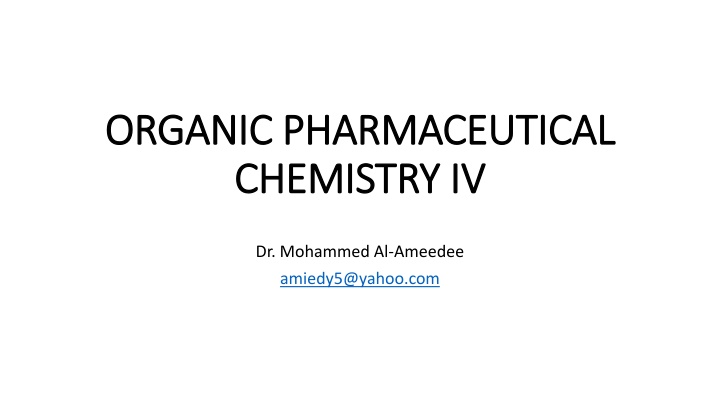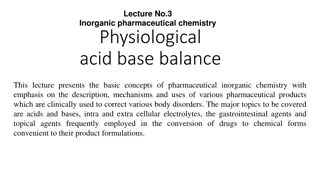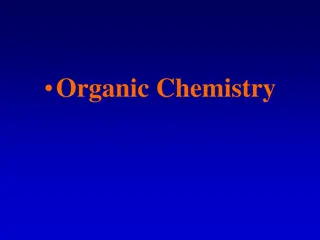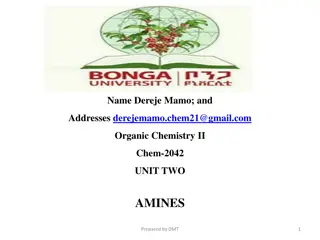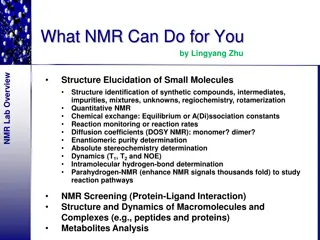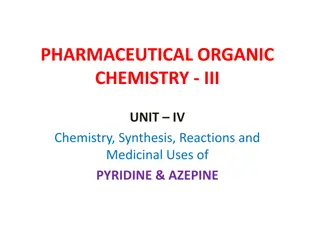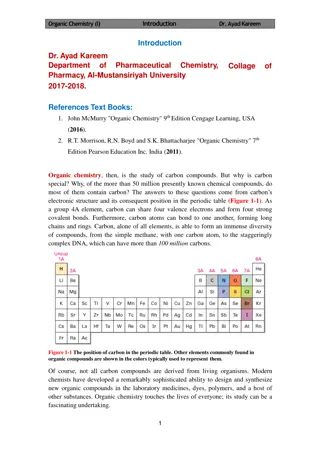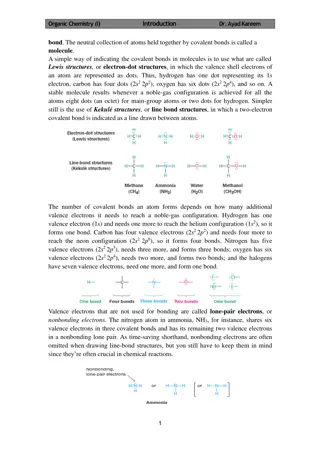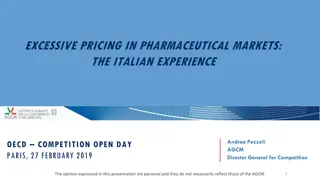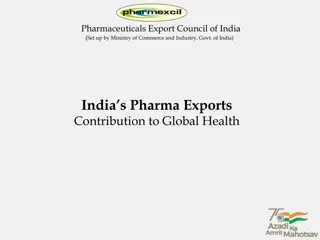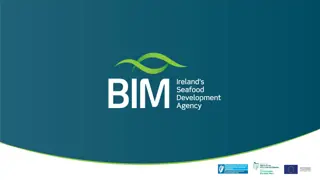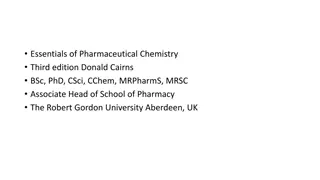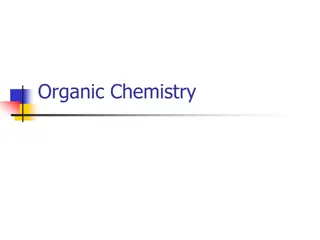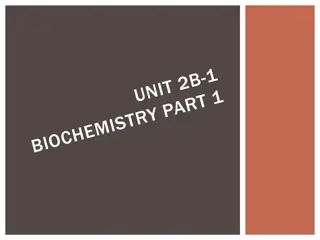ORGANIC PHARMACEUTICAL CHEMISTRY IV
This initiative aims to provide portable computing devices to every student in participating schools, promoting equity and enhancing learning through technology. The program includes teacher benefits, professional development classes, and wireless network setups.
Uploaded on Mar 09, 2025 | 2 Views
Download Presentation

Please find below an Image/Link to download the presentation.
The content on the website is provided AS IS for your information and personal use only. It may not be sold, licensed, or shared on other websites without obtaining consent from the author.If you encounter any issues during the download, it is possible that the publisher has removed the file from their server.
You are allowed to download the files provided on this website for personal or commercial use, subject to the condition that they are used lawfully. All files are the property of their respective owners.
The content on the website is provided AS IS for your information and personal use only. It may not be sold, licensed, or shared on other websites without obtaining consent from the author.
E N D
Presentation Transcript
ORGANIC PHARMACEUTICAL ORGANIC PHARMACEUTICAL CHEMISTRY IV CHEMISTRY IV Dr. Mohammed Al-Ameedee amiedy5@yahoo.com
Drug Optimization Drug Optimization Strategies in drug design Strategies in drug design A number of lead analogues should be synthesized according to the designed pharmacophore This is because most lead compounds have low activity, poor selectivity, and significant side effects. They may also be difficult to synthesize, so there is an advantage in finding analogues with improved properties Several strategies are used to optimize the interactions of a drug with its target in order to gain better activity and selectivity
Variation in substituents Variation in substituents Certain alkyl substituents can be varied more easily than others The alkyl substituents of ethers, amines, esters, and amides are easily varied In these cases, the alkyl substituent already present can be removed and replaced by another substituent Alkyl substituents which are part of the carbon skeleton of the molecule are not easily removed, and it is usually necessary to carry out a full synthesis in order to vary them
Variation in substituents Variation in substituents
Variation in substituents Variation in substituents If alkyl groups are interacting with a hydrophobic pocket in the binding site, then varying the length and bulk of the alkyl group (e.g. methyl, ethyl, propyl, butyl, isopropyl, isobutyl, or t -butyl) allows one to investigate the depth and width of the pocket Choosing a substituent that will fill the pocket will then increase the binding interaction Larger alkyl groups may also add selectivity on the drug In the case of a compound that interacts with two different receptors, a bulkier alkyl substituent may prevent the drug from binding to one of those receptors and so cut down side effects
Variation in substituents Variation in substituents
Variation in substituents Variation in substituents isoprenaline is an analogue of adrenaline where a methyl group was replaced by an isopropyl group, resulting in selectivity for adrenergic -receptors over adrenergic -receptors
Variation in substituents Variation in substituents In case of aromatic containing drugs, changing of the position of substituents on the aromatic ring could lead to change of pharmacological activity
Variation in substituents Variation in substituents The best anti-arrythmic activity for a series of benzopyrans was found when the sulphonamide substituent was at position 7 of the aromatic ring
Extension of the structure Extension of the structure The strategy of extension involves the addition of another functional group or substituent to the lead compound in order to probe for extra binding interactions with the target Lead compounds are capable of fitting the binding site and have the necessary functional groups to interact with some of the important binding regions present However, it is possible that they do not interact with all the binding regions available A lead compound may bind to three binding regions in the binding site but fail to use a fourth
Extension of the structure Extension of the structure
Extension of the structure Extension of the structure A good example of the use of extension tactics to increase binding intacertions involves the design of the ACE inhibitor enalaprilate from the lead compound succinyl proline
Chain extension/contraction Chain extension/contraction Some drugs have two important binding groups linked together by a chain, in which case it is possible that the chain length is not ideal for the best interaction Therefore, shortening or lengthening the chain length is a useful tactic to try
Chain extension/contraction Chain extension/contraction The cofactor NADH is bound next to estrone in the active site, and so it was reasoned that a direct bonding interaction between an estrone analogue and NADH would lock the analogue into the active site and block access to estrone itself Therefore, the analogue would act as an enzyme inhibitor
Chain extension/contraction Chain extension/contraction
Ring expansion/contraction Ring expansion/contraction
Ring expansion/contraction Ring expansion/contraction
Bioisosteres Bioisosteres Isosteres are atoms or groups of atoms which share the same valency and which have chemical or physical similarities Isosteres can be used to determine whether a particular group is an important binding group or not by altering the character of the molecule in as controlled a way as possible Isosteric groups could be used to determine whether a particular group is involved in hydrogen bonding Replacing OH with CH 3 would completely eliminate hydrogen bonding, whereas replacing OH with NH 2 would not
Bioisosteres Bioisosteres
Bioisosteres Bioisosteres The -blocker propranolol has an ether linkage Replacement of the OCH2segment with the isosteres CH = CH, SCH2, or CH 2 CH 2 eliminates activity, whereas replacement with NHCH 2 retains activity These results show that the ether oxygen is important to the activity of the drug
Simplification of the structure Simplification of the structure Simplification is a strategy which is commonly used on the oft en complex lead compounds arising from natural sources Once the essential groups of such a drug have been identified by SAR, it is oft en possible to discard the non-essential parts of the structure without losing activity Consideration is given to removing functional groups which are not part of the pharmacophore, simplifying the carbon skeleton Consider our hypothetical natural product glipine The essential groups have been highlighted and we might aim to synthesize simplified compounds in the order shown
Simplification of the structure Simplification of the structure
Structure Structure- -based drug design and based drug design and molecular modelling molecular modelling If the drug target can be isolated and crystallized, then it may be possible to determine the structure using X-ray crystallography This does not tell where the binding site is, and so it is better to crystallize the protein with a known inhibitor or antagonist (ligand) bound to the binding site X-ray crystallography can then be used to determine the structure of the complex and this can be downloaded to a computer Molecular modelling software is then used to identify where the ligand is and thus identify the binding site
Structure Structure- -based drug design and based drug design and molecular modelling molecular modelling By measuring the distances between the atoms of the ligand and neighbouring atoms in the binding site, it is possible to identify important binding interactions between the ligand and the binding site Then, the ligand can be removed from the binding site in silico and novel lead compounds can be inserted in silico to see how well they fit Regions in the binding site which are not occupied by the lead compound can be identified and used to guide the medicinal chemist as to what modifications and additions can be made to design a new drug that occupies more of the available space and binds more strongly
Structure Structure- -based drug design and based drug design and molecular modelling molecular modelling The drug can then be synthesized and tested for activity If it proves active, the target protein can be crystallized with the new drug bound to the binding site, and then X-ray crystallography and molecular modelling can be used again to identify the structure of the complex to see if binding took place as expected This approach is known as structure-based drug design A related process is known as de novo drug design. This involves the design of a novel drug structure, based on a knowledge of the binding site alone
Structure Structure- -based drug design and based drug design and molecular modelling molecular modelling This approach was used in the design of an anticancer agent called crizotinib, and included a great modification which totally altered the scaffold of the molecule PHA-665752 was the starting point for this research and had been obtained from structure-based drug design of a previous lead compound However, it had a large molecular weight and was too hydrophobic to be orally active The structure was co-crystallized with the target enzyme and the crucial binding interactions were identified
Structure Structure- -based drug design and based drug design and molecular modelling molecular modelling These included the dihydroindolone ring system which formed two important hydrogen bonds (hydrogen bond donor and hydrogen bond acceptor), as well as the dichloroaromatic ring it was noted that much of the scaffold connecting these binding groups was useless, and so a much simpler, less hydrophobic skeleton was designed which would position the important binding groups in a similar but more efficient way The modification involved a ring fusion, ring cleavage, and chain contraction. When the novel structures were synthesized, they were found to bind as predicted, and further structure-based drug design was used in the optimization process leading to crizotinib
Structure Structure- -based drug design and based drug design and molecular modelling molecular modelling
The element of luck The element of luck This role of luck was never eliminated in the drug industry Most of the drugs currently on the market were developed by a mixture of rational design, trial and error, hard graft , and pure luck The design of the -blocker propranolol is one of these examples In the development of -blockers, the project reached to a stage which involved introduction of various linking groups between the naphthalene ring and the ethanolamine portion of the molecule
The element of luck The element of luck At this stage, a chance event occurred The researchers wanted to use -naphthol as a starting material in order to introduce a linking group of X = O-CH2
The element of luck The element of luck However, the stores had run out of the reagent and so -naphthol was used instead to prepare the structure now known as propranolol In this structure, the chain was at the 1-position of the naphthalene ring rather than the 2-position, and nobody expected it to be active Propranolol was found to be a pure antagonist, having 10 20 times greater activity than pronethalol It was introduced into the clinic for the treatment of angina and is now the benchmark against which all -blockers are rated Its contribution to medicine was so significant that its inventor, James Black, received the Nobel Prize in 1988
